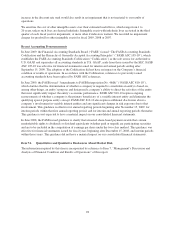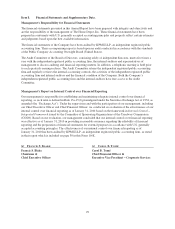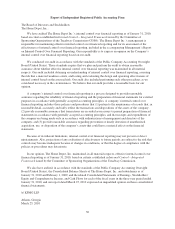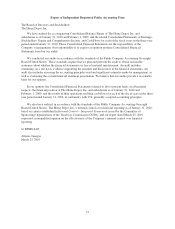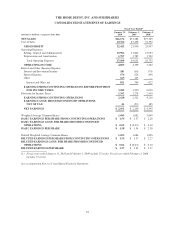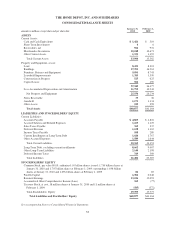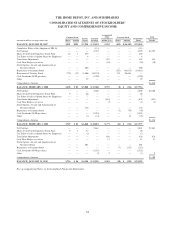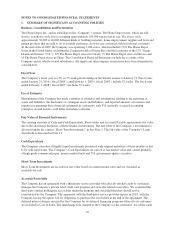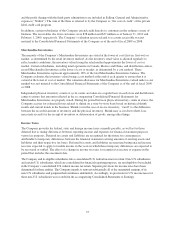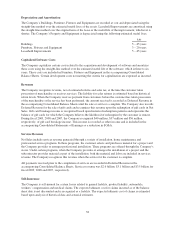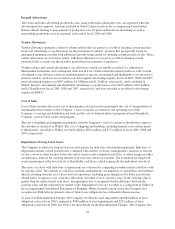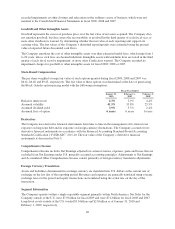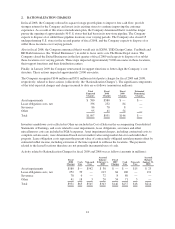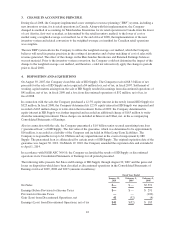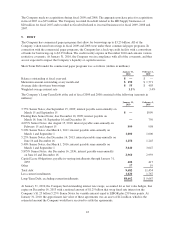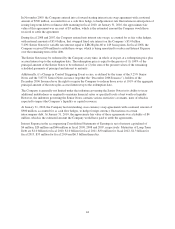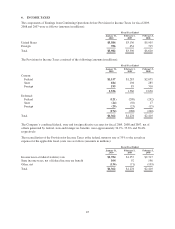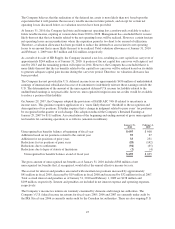Home Depot 2009 Annual Report Download - page 43
Download and view the complete annual report
Please find page 43 of the 2009 Home Depot annual report below. You can navigate through the pages in the report by either clicking on the pages listed below, or by using the keyword search tool below to find specific information within the annual report.and the profit sharing with the third-party administrator are included in Selling, General and Administrative
expenses (“SG&A”). The sum of the three is referred to by the Company as “the cost of credit” of the private
label credit card program.
In addition, certain subsidiaries of the Company extend credit directly to customers in the ordinary course of
business. The receivables due from customers were $38 million and $37 million as of January 31, 2010 and
February 1, 2009, respectively. The Company’s valuation reserve related to accounts receivable was not
material to the Consolidated Financial Statements of the Company as of the end of fiscal 2009 or 2008.
Merchandise Inventories
The majority of the Company’s Merchandise Inventories are stated at the lower of cost (first-in, first-out) or
market, as determined by the retail inventory method. As the inventory retail value is adjusted regularly to
reflect market conditions, the inventory valued using the retail method approximates the lower of cost or
market. Certain subsidiaries, including retail operations in Canada, Mexico and China, and distribution centers,
record Merchandise Inventories at the lower of cost or market, as determined by a cost method. These
Merchandise Inventories represent approximately 18% of the total Merchandise Inventories balance. The
Company evaluates the inventory valued using a cost method at the end of each quarter to ensure that it is
carried at the lower of cost or market. The valuation allowance for Merchandise Inventories valued under a cost
method was not material to the Consolidated Financial Statements of the Company as of the end of fiscal 2009
or 2008.
Independent physical inventory counts or cycle counts are taken on a regular basis in each store and distribution
center to ensure that amounts reflected in the accompanying Consolidated Financial Statements for
Merchandise Inventories are properly stated. During the period between physical inventory counts in stores, the
Company accrues for estimated losses related to shrink on a store-by-store basis based on historical shrink
results and current trends in the business. Shrink (or in the case of excess inventory, “swell”) is the difference
between the recorded amount of inventory and the physical inventory. Shrink may occur due to theft, loss,
inaccurate records for the receipt of inventory or deterioration of goods, among other things.
Income Taxes
The Company provides for federal, state and foreign income taxes currently payable, as well as for those
deferred due to timing differences between reporting income and expenses for financial statement purposes
versus tax purposes. Deferred tax assets and liabilities are recognized for the future tax consequences
attributable to temporary differences between the financial statement carrying amounts of existing assets and
liabilities and their respective tax bases. Deferred tax assets and liabilities are measured using enacted income
tax rates expected to apply to taxable income in the years in which those temporary differences are expected to
be recovered or settled. The effect of a change in income tax rates is recognized as income or expense in the
period that includes the enactment date.
The Company and its eligible subsidiaries file a consolidated U.S. federal income tax return. Non-U.S. subsidiaries
and certain U.S. subsidiaries, which are consolidated for financial reporting purposes, are not eligible to be included
in the Company’s consolidated U.S. federal income tax return. Separate provisions for income taxes have been
determined for these entities. The Company intends to reinvest substantially all of the unremitted earnings of its
non-U.S. subsidiaries and postpone their remittance indefinitely. Accordingly, no provision for U.S. income taxes for
these non-U.S. subsidiaries was recorded in the accompanying Consolidated Statements of Earnings.
37



